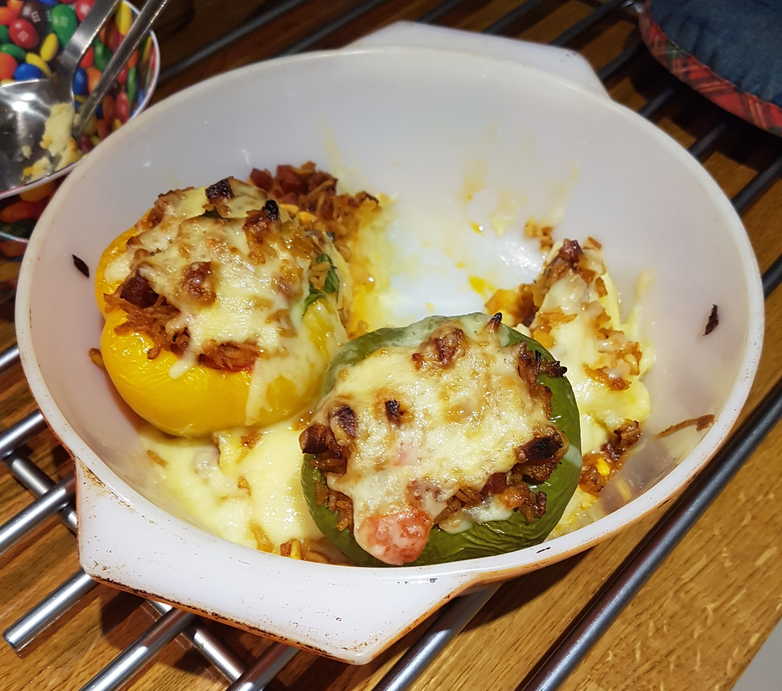
A Hallowe'en Hoosegow

Or how to celebrate your Birthday in the Covid Brig. Like that guy on the left.
Well we've now suffered er, enjoyed two birthdays during the most recent Covid restrictions so I know whereof I speak, And the answer seems to involve plenty of cooking.
And a Rice Krispie® birthday cake.
Oh, and drink. Don't forget the drink. You'll need lots of that too.
To bring you all up to speed: Since moving down to Bradford in July I've settled firmly into my new role as the resident uncle. One of my charges (the girl) managed to escape but we're keeping a firm hold on the other one.
Life has established a more regular grind now that I've finally begun that job with Lucifer's Own Services - yep, the one they first offered me in March: On the very day the lockdown(s) started!
Well they eventually got me going working from home. So my day now consists of the following punishing schedule:
Luxury!
So my recent cookery has been constrained not only by the available time, but also by the available audience. To whit, two Philistines.
One a ten-year-old, and the other with the palate of a ten-year-old.
Both utterly terrified of anything new or unexpected on their plates.
I treated the family to Mother's (watery) fish slop er, pie together with some pretty good brussels cooked with chorizo. My brother opined that he didn't believe fish and chorizo went together - seemingly unaware of the vast collection of popular fish and chorizo dishes, never mind the many excellent examples on this very website!
See that extensive list of acceptable foods? That's not just for the kids 😢
Well we've now suffered er, enjoyed two birthdays during the most recent Covid restrictions so I know whereof I speak, And the answer seems to involve plenty of cooking.
And a Rice Krispie® birthday cake.
Oh, and drink. Don't forget the drink. You'll need lots of that too.
To bring you all up to speed: Since moving down to Bradford in July I've settled firmly into my new role as the resident uncle. One of my charges (the girl) managed to escape but we're keeping a firm hold on the other one.
Life has established a more regular grind now that I've finally begun that job with Lucifer's Own Services - yep, the one they first offered me in March: On the very day the lockdown(s) started!
Well they eventually got me going working from home. So my day now consists of the following punishing schedule:
- 0700-0930: Get George clothed, fed and safely delivered to school.
- 0930-1430: Work.
- 1430-1600: Collect George from school.
- 1600-1700: Work.
- 1700-1900: Cook and eat dinner with George and Kurt.
- 1900-2000: Work.
- 2000-2100: See Kurt off to his job. Prepare George his evening fruit (which is a thing in our house) and clear the kitchen.
- 2100-2200: Work.
- 2200-2400: Prepare tomorrow's dinner.
- 0000-0700: My time is all my own!
Luxury!
So my recent cookery has been constrained not only by the available time, but also by the available audience. To whit, two Philistines.
One a ten-year-old, and the other with the palate of a ten-year-old.
Both utterly terrified of anything new or unexpected on their plates.
I treated the family to Mother's (watery) fish slop er, pie together with some pretty good brussels cooked with chorizo. My brother opined that he didn't believe fish and chorizo went together - seemingly unaware of the vast collection of popular fish and chorizo dishes, never mind the many excellent examples on this very website!
See that extensive list of acceptable foods? That's not just for the kids 😢
Rice Krispie Treats
sweet
Rice Krispie treats (or squares) are a great way to use up spare Rice Krispies®
if you happen to be drowning in them because your brother's son's school keeps sending boxes of them home for free
in the mistaken belief that their pupils do not get fed in the morning.
Or that if they weren't a simple box of cereal would resolve the problem.
A giant Rice Krispie Treat also makes a handy birthday cake for eager young helpers to make.
The convenient ratios below are actually American measures, but they're basically close enough to imperial sizes not to worry about converting - I didn't! 6 U.S. cups are about 5 Imperial cups, if you want to fuss.
A giant Rice Krispie Treat also makes a handy birthday cake for eager young helpers to make.
The convenient ratios below are actually American measures, but they're basically close enough to imperial sizes not to worry about converting - I didn't! 6 U.S. cups are about 5 Imperial cups, if you want to fuss.
Makes about a dozen squares
Ingredients
- 6 cups Rice Krispies® 180g/6oz
- 6 cups marshmallows 300g/10oz
- 6 tablespoons butter about 85g/3oz
- ½ tsp vanilla essence
- pinch of salt
Line a biscuit or a cake tin with lightly oiled baking parchment
honestly you won't need the paper unless you want to lift the thing out whole
- the mixture won't stick well to a lightly oiled ceramic or non-stick dish.
You can fill the tin first with Krispies to gauge the recipe quantities you'll need.
Gently melt the butter in a large pan, add the marshmallows and stir until they all melt together. Make sure the marshmallows are completely melted and blended in, but don't overcook them.
Stir in a pinch of salt and the vanilla essence, then the Rice Krispies. Mix thoroughly so all the Krispies are coated.
Scoop out the sticky mixture and lightly press into the cake tin using a lightly oiled spatula or gloves then gently smooth off the top (if you over-compress it the Krispie will set too hard).
Allow to cool for at least an hour then cut into squares.
Keep them in a sealed container if storing them for more than a few hours.
Gently melt the butter in a large pan, add the marshmallows and stir until they all melt together. Make sure the marshmallows are completely melted and blended in, but don't overcook them.
Stir in a pinch of salt and the vanilla essence, then the Rice Krispies. Mix thoroughly so all the Krispies are coated.
Scoop out the sticky mixture and lightly press into the cake tin using a lightly oiled spatula or gloves then gently smooth off the top (if you over-compress it the Krispie will set too hard).
Allow to cool for at least an hour then cut into squares.
Keep them in a sealed container if storing them for more than a few hours.
Candied Butternut Squash and Sweetcorn with Marshmallows
veg side cheese
Young Philistine George alleged that he would eat anything with marshmallows on it, so I decided to test his claim.
I must record that he did in fact eat the marshmallows, but refused the sweet potato mash beneath.
Elder Philistine Kurt reluctantly ate some sweet potato, but refused the marshmallow. Too strange. Too yucky. Another partial success. 🙄
Inspired by America's candied yams (sweet potatoes), and the marshmallows leftover from Kurt's Rice Krispie Birthday cake, I made this out of things I had in the fridge - so my cream cheese was a mixture of Philadelphia's original and caramelised onion flavours. I thought it might need a splash of cream, but that wasn't required.
I actually tried grilling the marshmallows to finish this dish, but they burn very easily unless you keep the dish a long way from the grill. So I'd recommend baking them.
Elder Philistine Kurt reluctantly ate some sweet potato, but refused the marshmallow. Too strange. Too yucky. Another partial success. 🙄
Inspired by America's candied yams (sweet potatoes), and the marshmallows leftover from Kurt's Rice Krispie Birthday cake, I made this out of things I had in the fridge - so my cream cheese was a mixture of Philadelphia's original and caramelised onion flavours. I thought it might need a splash of cream, but that wasn't required.
I actually tried grilling the marshmallows to finish this dish, but they burn very easily unless you keep the dish a long way from the grill. So I'd recommend baking them.
Serves 4
Ingredients
- 1 butternut squash
- 1 ear sweet corn
- 1 teaspoon smoked paprika
- couple tablespoons cream cheese
- salt
- 1-2 cups mini marshmallows to cover
Preheat the oven to 400°F/200°C/Gas Mark 6.
Cut the squash in half length-wise and scoop out the seeds. Lightly oil or butter the cut face, place cut-side down on an oven tray and roast in the oven until squishy - about 40 minutes. Then turn the oven up to hot - 450°F/230°C/Gas Mark 8.
Bring a pot of water to boil and cook the corn until it is tender - about 10 minutes. Drain, then slice the kernels away from the core, break them apart and set them aside.
Cut the squash in half length-wise and scoop out the seeds. Lightly oil or butter the cut face, place cut-side down on an oven tray and roast in the oven until squishy - about 40 minutes. Then turn the oven up to hot - 450°F/230°C/Gas Mark 8.
Bring a pot of water to boil and cook the corn until it is tender - about 10 minutes. Drain, then slice the kernels away from the core, break them apart and set them aside.
Or you could roast the corn in the oven for 30 minutes with the squash - seasoned, buttered and wrapped in foil.
Simmering it does mean it comes out moist and properly cooked though.
When the squash is soft, scoop the flesh out from the skin, mash together with the paprika, cream cheese and salt to taste.
Mix in the corn then ladle into a small oven-proof dish.
Cover with a double layer of mini marshmallows,
then return to the hotter oven for 10-15 minutes until the marshmallows melt together and develop a golden crust.
Opinions varied Bloody Philistines! but I really liked it :)
Shepherd's Pie
main meat
An Irish speciality. Apparently.
Traditionally made using leftover lamb, but we are all too rich to have leftovers these days.
Traditionally made using leftover lamb, but we are all too rich to have leftovers these days.
Serves 4
Ingredients
- 500g lamb mince
- 1-2 onions, minced
- 2 cloves garlic, minced
- olive oil for frying
- 1-2 carrots, finely diced optional
- 1-2 sticks celery, finely diced optional
- thyme leaves
- 1-2 tblsps tomato ketchup or purée
- 1 tblsp Worcestershire sauce
- 300-500ml stock Preferably lamb, but anything will do. OK, maybe not fish.
- ½-1kg potato
- butter, lots of butter
- 2 egg yolks
- salt & pepper
Heat a splash of olive oil in a frying pan and fry the minced onion until it begins to nicely caramelize.
Add the minced garlic and the thyme leaves finely chopped rosemary is also an option,
stir and cook a little longer. Scoop out and set aside.
Heat more oil and fry the mince, added in batches, until browned, pressing down with the back of a wooden spoon to separate the grains. Add the diced carrot and celery if using, and fry until softened. Add the tomato ketchup or purée, stir in and fry a little you can bubble off some red or white wine now too, if you like, then add the Worcestershire sauce, return the onion to the pan and cover the mixture with stock. I have been known to use an Oxo cube. When cooking for Philistines...
Simmer gently for 30 minutes then allow the mix to thicken and dry off.
Season with salt and pepper and ladle into an oven-proof dish.
Bake at 200°C/Gas Mark 6 (or slightly lower) for 30 minutes until golden brown and bubbling.
Heat more oil and fry the mince, added in batches, until browned, pressing down with the back of a wooden spoon to separate the grains. Add the diced carrot and celery if using, and fry until softened. Add the tomato ketchup or purée, stir in and fry a little you can bubble off some red or white wine now too, if you like, then add the Worcestershire sauce, return the onion to the pan and cover the mixture with stock. I have been known to use an Oxo cube. When cooking for Philistines...
Simmer gently for 30 minutes then allow the mix to thicken and dry off.
Season with salt and pepper and ladle into an oven-proof dish.
If you want to ruin it you can add peas, sweetcorn, par-boiled cauliflower florets, or any other vegetables you happen to have left over or in the freezer.
Meanwhile peel the potatoes, cut into reasonably big chunks and boil until on the point of falling apart.
Drain, allow to stream dry and cool for few minutes then mash with a very generous lump of butter and two egg yolks until silky smooth. Season with salt.
You could add cheese (say, parmesan) to the mash, but it's not really traditional - that's more of a cottage pie trick.
Other root vegetables are also available.
Cover the mince in the dish with the mash, smooth over and then make grooves or furrows using a large fork or similar
this, together with the egg yolks, will help to give a nice golden crust -
if you want to be extra posh you can pipe in the mash instead.Bake at 200°C/Gas Mark 6 (or slightly lower) for 30 minutes until golden brown and bubbling.
A classic!
Chorizo and Rice Stuffed Peppers
main meat cheese
Made for picky eaters.
I might have added some raisins, but picky eaters won't touch raisins!
I might have added some raisins, but picky eaters won't touch raisins!
Serves 3-4
Ingredients
- 1 onion, finely chopped
- 2 cloves garlic, minced
- 100g chorizo, chopped
- ¼ tsp dried oregano or thyme
- 1 tblsp tomato purée
- 2-3 cups cooked rice
- a couple of medium tomatoes or 6-8 cherry tomatoes, diced
- 25g pine nuts, toasted
- a little stock or gravy
- salad leaves or fresh herbs, chopped
- 3-4 bell peppers
- 100g cheese, grated
Heat the oven to 200°C/Gas Mark 6.
Cut the top from each bell pepper and remove the core, seeds and any white ribs from inside. Find a casserole dish into which they fit nicely, drizzle with a little olive oil, and roast for 20-30 minutes until softened, but not quite collapsed. (They won't soften much more whilst cooking filled unless you cover the dish with foil for about 30 minutes.)
Season their insides.
Toast the pine nuts in a dry frying pan until they begin to colour. Set aside.
Lubricate the frying pan with olive oil and add the finely chopped onion. Fry until beginning to caramelise.
Add the chopped chorizo, minced garlic and dried herbs and fry until the chorizo sweats out its oil.
Add the tomato purée and fry.
Add the cooked rice and continue frying.
Add the diced tomato and continue frying.
Stir in enough stock to moisten the rice and remove from the heat.
Season, mix in the sliced leaves and fill the peppers. I used leftover mashed potatoes to support the peppers (in my too-large casserole), which turned out to be very tasty in itself.
Grate over the cheese and return to the oven for 10-15 minutes until the cheese bubbles and colours.
Cut the top from each bell pepper and remove the core, seeds and any white ribs from inside. Find a casserole dish into which they fit nicely, drizzle with a little olive oil, and roast for 20-30 minutes until softened, but not quite collapsed. (They won't soften much more whilst cooking filled unless you cover the dish with foil for about 30 minutes.)
Season their insides.
Toast the pine nuts in a dry frying pan until they begin to colour. Set aside.
Lubricate the frying pan with olive oil and add the finely chopped onion. Fry until beginning to caramelise.
Add the chopped chorizo, minced garlic and dried herbs and fry until the chorizo sweats out its oil.
Add the tomato purée and fry.
Add the cooked rice and continue frying.
Add the diced tomato and continue frying.
Stir in enough stock to moisten the rice and remove from the heat.
Season, mix in the sliced leaves and fill the peppers. I used leftover mashed potatoes to support the peppers (in my too-large casserole), which turned out to be very tasty in itself.
Grate over the cheese and return to the oven for 10-15 minutes until the cheese bubbles and colours.
Picky little eaters may choose to leave the pepper flesh, but they'll probably eat the fried rice stuffing. Which is pretty tasty.
Whole Roasted Salmon with Lemon and Herbs
fish main
I didn't have any wine I know!! to make this with
so I simmered up the salmon's head and tail with some carrot and onion and a glass of Ricard to make a fish stock to lubricate the dish with instead.
I also skipped the fennel I didn't have.
It's actually not too bad - however the lemon really needs the pith removing to reduce its bitterness, and you'll probably want to parboil the potatoes.
It's actually not too bad - however the lemon really needs the pith removing to reduce its bitterness, and you'll probably want to parboil the potatoes.
Serves 4
Ingredients
- a glug of olive oil
- 1 fennel bulb, sliced
- 4 garlic cloves, finely sliced
- 1 medium white onion, peeled and sliced
- 14 new potatoes, scrubbed but unpeeled, halved lengthways
- ½ bunch curly parsley
- ½ bunch tarragon
- ½ bunch dill
- 1 unwaxed lemon
- 1 x 2.5kg whole salmon, skin on, gutted
- 125ml white wine or fish stock
Preheat the oven to 220°C/200°C fan/Gas 7.
Place a large sheet of tin foil (large enough to wrap the fish loosely) in a large baking tray. Drizzle a good glug of olive oil over the foil.
Place the sliced fennel, garlic, onion and halved potatoes in a bowl, season well, spread out on the foil, then toss them in the oil.
Make some slashes though the skin of the salmon and stuff the slashes with the herb mixture. Slice the zested lemon you really should cut away excess pith first and stuff the cavity of the fish with the lemon slices and the rest of the herbs.
Set the fish on the vegetables in the tray, season, then pour in the wine or fish stock. Bring up and seal the edges of the foil to make a loose tent around the salmon. If you're covering with a second piece don't forget to oil it so it doesn't stick to the salmon's skin.
Roast for 15 minutes then turn the heat down to 200°C/180°C fan/Gas 6 and continue with the roasting for another 30 minutes.
To check if the salmon is done, use a skewer to pierce the thickest part of the fish, by the head. Place the skewer to touch your lips - if it is warm which it certainly should be, the salmon is cooked. Return to the oven if not, and cook for a further 10 or 15 minutes.
Remove from the oven and serve immediately.
Place a large sheet of tin foil (large enough to wrap the fish loosely) in a large baking tray. Drizzle a good glug of olive oil over the foil.
Place the sliced fennel, garlic, onion and halved potatoes in a bowl, season well, spread out on the foil, then toss them in the oil.
I'd suggest par-boiling the potatoes for 10 minutes first, if you want them to end up cooked!
Take half of the herbs and chop them roughly. Grate the zest of the lemon and chop this through the herb mixture.Make some slashes though the skin of the salmon and stuff the slashes with the herb mixture. Slice the zested lemon you really should cut away excess pith first and stuff the cavity of the fish with the lemon slices and the rest of the herbs.
Set the fish on the vegetables in the tray, season, then pour in the wine or fish stock. Bring up and seal the edges of the foil to make a loose tent around the salmon. If you're covering with a second piece don't forget to oil it so it doesn't stick to the salmon's skin.
Roast for 15 minutes then turn the heat down to 200°C/180°C fan/Gas 6 and continue with the roasting for another 30 minutes.
To check if the salmon is done, use a skewer to pierce the thickest part of the fish, by the head. Place the skewer to touch your lips - if it is warm which it certainly should be, the salmon is cooked. Return to the oven if not, and cook for a further 10 or 15 minutes.
Remove from the oven and serve immediately.
Not too bad - you'll need to separate the top half of the fish from the ribs and backbone and serve in sections using a fish slice or palette knife.
Then you can lift away the bones and similarly serve out the bottom half.
Chorizo and Bacon Pasta Sauce
main meat pasta
The apple might seem odd, but it works very well. It cooks down into the sauce and is barely noticeable.
Don't overdo the capers if you're cooking for young Philistines, just disguise them amongst the peas. Kids know and accept peas ;)
The broccoli was, frankly, a mistake, but some chopped parsley might have been nice.
Don't overdo the capers if you're cooking for young Philistines, just disguise them amongst the peas. Kids know and accept peas ;)
The broccoli was, frankly, a mistake, but some chopped parsley might have been nice.
Serves 4
Ingredients
- a couple of anchovies, chopped
- 2 onions, minced
- 2 carrot, finely chopped
- 100g chorizo, diced
- 150g bacon, chopped
- 3 garlic cloves, minced
- 2 tbsps tomato purée
- 1 tbsp capers
- a dozen fresh cherry tomatoes, diced
- 1 tin chopped tomatoes
- stock
- ½ dessert apple yes, apple!, peeled, cored, finely chopped
- broccoli stalks, diced or not
- 100g frozen peas
Mince a couple of anchovies with their flavoured olive oil and sweat a little before adding the minced onion and carrot.
Continue cooking until the vegetables soften and begin to caramelize, then add the chopped bacon and fry, then the diced chorizo and garlic and fry. Stir through the tomato purée with the capers, then add the fresh tomatoes and fry until they begin to break down.
Finally mix in the tinned tomatoes and enough stock to cover. Add the diced apple and any broccoli stalks you desperately need to be rid of, finely chopped.
Simmer for about 30 minutes until everything is tender and the sauce has reduced, then add the frozen peas. Reheat, simmer for 5 or 10 minutes and serve over pasta with grated cheese.
Continue cooking until the vegetables soften and begin to caramelize, then add the chopped bacon and fry, then the diced chorizo and garlic and fry. Stir through the tomato purée with the capers, then add the fresh tomatoes and fry until they begin to break down.
Finally mix in the tinned tomatoes and enough stock to cover. Add the diced apple and any broccoli stalks you desperately need to be rid of, finely chopped.
Simmer for about 30 minutes until everything is tender and the sauce has reduced, then add the frozen peas. Reheat, simmer for 5 or 10 minutes and serve over pasta with grated cheese.
Not too bad, even young George ate it!
Cottage Pie
main meat cheese
I must admit to adding some leftover chorizo and bacon pasta sauce to the meat mixture below.
I think any of the sauce ingredients might be a useful addition to your cottage pie. (Yes, even the apple and the anchovies.)
It certainly didn't do my cottage pie any harm.
A little parsley chopped into the mashed potato wouldn't go amiss either.
A little parsley chopped into the mashed potato wouldn't go amiss either.
Serves 8
Ingredients
- 1kg beef mince
- olive oil
- ground pepper
- 2 onions, finely chopped
- 2 carrots, chopped
- 2 celery sticks, chopped
- 4 garlic cloves, finely chopped
- 2 tbsps tomato ketchup or purée
- 1-2 cups red wine
- 1 litre beef stock
- a few tbsps Worcestershire sauce
- a few bay leaves
- handful of thyme sprigs, leaves only
For the Topping:- 1.5 kg potatoes
- 50g butter
- 200g strong cheddar, grated
- a dollop of mayonnaise, an egg or a splash of milk
- salt
Heat a generous puddle of olive oil in a large deep frying pan, add the bay leaves and a generous grinding of black peppercorns then fry the mince,
in batches if necessary, until browned.
Remove the bay leaves and set the meat aside.
Generously re-oil the pan and add the finely chopped onion and the chopped carrots and celery (cut as small as you prefer). Cook gently until soft - about 30 minutes.
Add the minced garlic and the tomato ketchup (or purée), raise the heat a little and fry for a few minutes. You can add a couple of tablespoons of flour at this point if you don't have a rich enough stock to thicken the sauce. Return the meat to the pan.
Add the red wine and bubble off a little, then add the stock, some Worcestershire sauce and thyme leaves.
Bring to a simmer and cook, uncovered for 30-45 minutes until the sauce reduces and coats the meat stickily. Season and add more Worcestershire sauce if required.
Meanwhile, make the mash:
Peel the potatoes, cut into large chunks and simmer in a large lidded saucepan for about 30 minutes until easily pierced with a knife.
Drain then return to the pan and steam-dry for a few minutes before mashing with a generous amount of butter and the grated cheese. Loosen a little with a splash of milk, a good dollop of mayonnaise or a splash of milk or cream. Season with salt and a grating of nutmeg if you like
Spoon the meat mixture into an ovenproof dish, layer over the mash and roughen with a fork. Sprinkle with a little extra grated cheese if you like.
Bake in a 200°C/Gas Mark 6 oven for 30-40 minutes until the topping is golden and the contents bubbling.
Serve with buttered cabbage, carrots or peas.
Remove the bay leaves and set the meat aside.
Generously re-oil the pan and add the finely chopped onion and the chopped carrots and celery (cut as small as you prefer). Cook gently until soft - about 30 minutes.
Add the minced garlic and the tomato ketchup (or purée), raise the heat a little and fry for a few minutes. You can add a couple of tablespoons of flour at this point if you don't have a rich enough stock to thicken the sauce. Return the meat to the pan.
Add the red wine and bubble off a little, then add the stock, some Worcestershire sauce and thyme leaves.
Bring to a simmer and cook, uncovered for 30-45 minutes until the sauce reduces and coats the meat stickily. Season and add more Worcestershire sauce if required.
Meanwhile, make the mash:
Peel the potatoes, cut into large chunks and simmer in a large lidded saucepan for about 30 minutes until easily pierced with a knife.
Drain then return to the pan and steam-dry for a few minutes before mashing with a generous amount of butter and the grated cheese. Loosen a little with a splash of milk, a good dollop of mayonnaise or a splash of milk or cream. Season with salt and a grating of nutmeg if you like
Spoon the meat mixture into an ovenproof dish, layer over the mash and roughen with a fork. Sprinkle with a little extra grated cheese if you like.
Bake in a 200°C/Gas Mark 6 oven for 30-40 minutes until the topping is golden and the contents bubbling.
Serve with buttered cabbage, carrots or peas.
Classic!
George even said he liked it!
George even said he liked it!
Plum Crumble
veg vegan dessert
For when your neighbour's plum tree bears fruit.
So much fruit that they have to put them out in a box inviting passers-by to help themselves.
Unfortunately for everyone else, I passed by first...
So much fruit that they have to put them out in a box inviting passers-by to help themselves.
Unfortunately for everyone else, I passed by first...
Serves 6
Ingredients
- 2lb plums, halved, stoned
- sugar
- cinnamon powder
- orange zest optional
- a splash of water
For the Crumble Topping:- (175g) 6 oz plain flour
- (80g) 3 oz cold butter or some hideous vegan alternative, cubed
- (80g) 3 oz demerara sugar
- 50g ground or flaked almonds optional
Halve the plums, remove the stones and lay in an ovenproof dish.
Mix with enough sugar to take away the sourness (perhaps 50g), a teaspoon or so of ground cinnamon and some orange zest if you like.
Sprinkle with a little water or orange juice.
To make the crumble, you can either rub the butter into the flour by hand then stir in all the other ingredients, or just pulse everything up in a food processor until it just starts to clump together. Loosely scatter the crumble over the plums, topping with the flaked almonds if using.
Bake at 200°C/Gas Mark 6 for 30-40 minutes until the crumble is golden and bubbling.
Serve with custard, crème fraîche, cream, or ice cream. Or not.
To make the crumble, you can either rub the butter into the flour by hand then stir in all the other ingredients, or just pulse everything up in a food processor until it just starts to clump together. Loosely scatter the crumble over the plums, topping with the flaked almonds if using.
Bake at 200°C/Gas Mark 6 for 30-40 minutes until the crumble is golden and bubbling.
Serve with custard, crème fraîche, cream, or ice cream. Or not.
Rather good. Don't press down the crumble when covering the plums.
Easy Roast Duck Legs
fowl main
A sort of half-way house to a confit.
This method can be used to roast any small game leg.
Duck and goose are natural because they have a lot of fat under the skin, but you can do it with pheasant, grouse or turkey legs, or even rabbit or squirrel legs.
You'll need extra fat with the skinnier animals, substituting butter or lard if you can't get duck or goose fat. Olive oil also works.
Serves 1 per Leg
Ingredients
- duck or goose legs
- salt
- duck fat, or butter, lard or olive oil
Pat the duck or goose legs dry with paper towels.
If you have store-bought duck legs, prick the skin of the duck all over with a needle or the point of a sharp knife. Do not pierce the meat itself.
Piercing the skin gives the fat a place to seep out. Salt your duck legs well and set them aside, skin side up.
Let them come to room temperature for at least 30 minutes and up to 90 minutes.
Put the legs in a small casserole. How small? You want the casserole to be just big enough to hold the legs. Now you need some fat. If the legs themselves are fatty, you will only need to pour a thin sheen of oil or melted duck fat on the bottom of the casserole, then place the duck legs close together, but not overlapping. If the legs are skinny, add enough fat to come about ¼ inch up the sides of the dish.
Put the casserole in the oven and turn it to 150°C/300°F/Gas Mark 2; if you have a digital oven, you could even go down to 140°C/285°F/Gas Mark 1½. Do not preheat the oven. Every duck has a different level of fat, so done-ness is more an art than a science. But it will take at least 90 minutes, and probably two hours, and even 3 or 4 hours won't hurt them. After 90 minutes, check the duck: It should be partly submerged in melted fat and the skin should be getting crispy.
Put the legs in a small casserole. How small? You want the casserole to be just big enough to hold the legs. Now you need some fat. If the legs themselves are fatty, you will only need to pour a thin sheen of oil or melted duck fat on the bottom of the casserole, then place the duck legs close together, but not overlapping. If the legs are skinny, add enough fat to come about ¼ inch up the sides of the dish.
Put the casserole in the oven and turn it to 150°C/300°F/Gas Mark 2; if you have a digital oven, you could even go down to 140°C/285°F/Gas Mark 1½. Do not preheat the oven. Every duck has a different level of fat, so done-ness is more an art than a science. But it will take at least 90 minutes, and probably two hours, and even 3 or 4 hours won't hurt them. After 90 minutes, check the duck: It should be partly submerged in melted fat and the skin should be getting crispy.
I cooked my four thawed, frozen duck legs for 2 hours at Gas Mark 2 then turned them up to 4 for an hour, 5 for 30 minutes and 6 for another 15.
They weren't really cooking well to begin with, perhaps because I'd added a little too much goose fat,
but I spooned some out and they turned out rather nicely in the end.
When the skin is starting to look crispy, turn the heat to 190°C/375°F/Gas Mark 5. Check after 15 minutes. You're looking for a light golden brown.
Remove the casserole from the oven and let cool for 10 to 15 minutes before eating.
Save the accumulated fat for cooking vegetables, other meats or for keeping your skin shiny.
I strain the fat through a paper towel, but you really only need to do this if you are saving the fat for several weeks or months;
strained, it will keep for 6 months tightly covered in the fridge.
Well wrapped, the duck meat itself will last up to 2 weeks in the fridge.
Excellent legs - crispy skin and rich tender flesh. They can be eaten whole or pulled like pork. Serve with a citrus or vinegar sauce.
Say Orange or Cherry and Red Wine.
I filled out the spaces in the casserole dish with some rosemary sprigs and halved new potatoes which also turned out rather tasty. If greasy.
I filled out the spaces in the casserole dish with some rosemary sprigs and halved new potatoes which also turned out rather tasty. If greasy.
Cherry and Red Wine Sauce
sauce
Ideal for your roasted duck.
You can use frozen cherries for this sauce. It will reduce a long way to produce a thick sticky glaze, but if you want more sauce than this, thicken it earlier by adding a teaspoon of cornflour mixed with a little water when you have the quantity you'd like.
You can use frozen cherries for this sauce. It will reduce a long way to produce a thick sticky glaze, but if you want more sauce than this, thicken it earlier by adding a teaspoon of cornflour mixed with a little water when you have the quantity you'd like.
Serves 4
Ingredients
- 12-18 pitted cherries
- 50g caster sugar
- 3 tablespoons red wine vinegar
- 400ml chicken stock
- 175ml glass of red wine
- 1 teaspoon cherry or redcurrant jam (optional)
Place the sugar and red wine vinegar in a pan on a medium heat and reduce until you have a sticky golden caramel.
Pour in the wine and the stock and a half of the cherries and reduce by ⅔. Crush the cherries against the side of the pot as they boil then press the sauce through a sieve to remove the disintegrated cherry pulp. Return to the pot and continue reducing until you have the consistency you desire, then add in the remaining cherries (for decoration).
Taste and if it requires more sweetness, mix in the jam.
Pour in the wine and the stock and a half of the cherries and reduce by ⅔. Crush the cherries against the side of the pot as they boil then press the sauce through a sieve to remove the disintegrated cherry pulp. Return to the pot and continue reducing until you have the consistency you desire, then add in the remaining cherries (for decoration).
Taste and if it requires more sweetness, mix in the jam.
Excellent with roast duck legs!
Potato Gratin Dauphinoise
veg staple
Known variously as potato gratin, potato dauphinois, pommes de terre dauphinoise, potatoes à la dauphinoise, gratin dauphinoise etc.
Opinions vary as to whether cheese (preferably Gruyère) should be involved, but lean towards not,
that being more typically a gratin savoyard. Or just a gratin.
Opinions also vary as to whether the potatoes should be floury or waxy here I used Maris Pipers or if the slices should be washed free of their starch or not here not.
You decide!
I like to get things going by heating the garlic, cream and potatoes together in a pan before decanting to the oven to speed up the baking process, but you don't need to bother doing that if you have the time.
You will definitely get a much prettier, dense and more regular gratin if you carefully take each individual potato slice, coat both sides in the hot seasoned-cream-and-garlic mix and then tenderly lay it in the baking dish to produce even layers. Of course this makes for a more fiddly and time-consuming effort.
Opinions also vary as to whether the potatoes should be floury or waxy here I used Maris Pipers or if the slices should be washed free of their starch or not here not.
You decide!
I like to get things going by heating the garlic, cream and potatoes together in a pan before decanting to the oven to speed up the baking process, but you don't need to bother doing that if you have the time.
You will definitely get a much prettier, dense and more regular gratin if you carefully take each individual potato slice, coat both sides in the hot seasoned-cream-and-garlic mix and then tenderly lay it in the baking dish to produce even layers. Of course this makes for a more fiddly and time-consuming effort.
Serves 4
Ingredients
- perhaps 4 potatoes, sliced
- double cream
- 1-2 cloves garlic, crushed
- salt & white pepper
- nutmeg, grated
- butter
Crush the garlic into the cream in a large pan and season with salt, ground white pepper and a grating of nutmeg if you like.
Thinly slice the potatoes on a mandoline preferably and add them to the pan.
Separate each slice before adding to make sure they all get well coated.
When the mixture is heated through layer the potato into a baking dish, dot the top generously with butter, lightly cover with foil and bake in a low oven for one or two hours until the potato is tender and the top is golden brown.
The dish is not particularly sensitive to oven temperature, anywhere between Gas Mark ½ (120°C) and the bottom of a Gas Mark 6 (200°C).
When the mixture is heated through layer the potato into a baking dish, dot the top generously with butter, lightly cover with foil and bake in a low oven for one or two hours until the potato is tender and the top is golden brown.
The dish is not particularly sensitive to oven temperature, anywhere between Gas Mark ½ (120°C) and the bottom of a Gas Mark 6 (200°C).
Absolutely lovely.
Universally rejected by the Philistines who pronounced it sour and cheesy.
Universally rejected by the Philistines who pronounced it sour and cheesy.
Sausage and Potato Bake
main meat
A pretty good sausage bake.
You can add pretty much any vegetables you like - carrots, cauliflower. I added brussels sprouts - halving the larger ones. You can also throw in any selection of herbs - thyme, rosemary, sage, basil or parsley (to finish).
I made a few changes to Mary Berry's recipe written below:
You can add pretty much any vegetables you like - carrots, cauliflower. I added brussels sprouts - halving the larger ones. You can also throw in any selection of herbs - thyme, rosemary, sage, basil or parsley (to finish).
I made a few changes to Mary Berry's recipe written below:
- I used (a substantial quantity of) duck and goose fat rather than olive oil.
- I roasted just the halved new potatoes and the halved (or whole) garlic cloves well coated with the fat, covered, in a lower Gas 4 oven for an hour to get them started.
- I added brussels sprouts with the other vegetables, halving the larger ones.
- Since I was cooking for Philistines I substituted chicken stock for the wine.
Serves 4-6
Ingredients
- 2 tbsp olive oil
- 2 large onions red if you like, sliced lengthways into wedges
- 2 red peppers, deseeded and diced I preferred hefty chunks
- 2 garlic cloves, chopped or rather more just halved
- 1 tbsp chopped fresh thyme leaves
- 500g/1lb 2oz baby new potatoes, halved or you could cut larger potatoes into a similar size
- 12 sausages, pricked with a fork don't prick them with a fork! Never prick sausages!
- 200ml/7fl oz white wine or stock
- salt and freshly ground black pepper
Extras:- alternative vegetables
- any herbs
Preheat the oven to 220C/200C Fan/Gas 7.
Serve hot with a dollop of mustard on the side or cocottes.
This does seem just a little bit high to me, I'd go for Gas 6.
Place all the ingredients except the wine in a large, resealable freezer bag. Seal the bag shut and shake well to coat everything in the oil.
Alternatively, put everything in a large bowl and turn the ingredients until they are fully coated in the oil.
I used duck and goose fat leftover from (and flavoured by) roasting duck legs, and I pre-roasted the potatoes.
Tip into a large roasting tin, spreading the ingredients out into one even layer and ensuring that the sausages aren't covered by any of the vegetables.
Season well with salt and pepper. Roast for about 30–35 minutes until golden-brown.
My roasting tin was probably 3 layers deep :(
But I did make sure the sausages were on top.
Remove from the oven, turn the sausages over and toss the vegetables in the cooking juices.
Pour in the wine or stock and return to the oven for a further 20 minutes or until browned
and the sausages are cooked and the potatoes tender.But I did make sure the sausages were on top.
Serve hot with a dollop of mustard on the side or cocottes.
Very good.
Chicken Pasta Bake
main fowl pasta cheese
I was intrigued by the inclusion of chopped onion boiled along with the pasta
in this chicken bake recipe from Mary Berry.
In fact it turns the onion a bit slimy, or at least it did to the red onion I added half way through my pasta boiling.
Maybe I'll try it with white onion from the start of the pasta cooking, as suggested, but I can't see why just frying the onion wouldn't be better.
Anyhoo, I pepped up the recipe by frying some chopped bacon and thinly sliced chorizo to add to the fried chicken.
I added a tablespoon of flour to the paprika to coat the chicken strips, which need to be sliced quite thinly.
Alternatively you could fry larger pieces of chicken then slice them thinly afterwards, which might yield more tender pieces.
I figure you could also add peas or other vegetables to the pasta mixture.
In fact it turns the onion a bit slimy, or at least it did to the red onion I added half way through my pasta boiling.
Maybe I'll try it with white onion from the start of the pasta cooking, as suggested, but I can't see why just frying the onion wouldn't be better.
Yeah white onion slices added after 5 minutes worked reasonably well.
Anyhoo, I pepped up the recipe by frying some chopped bacon and thinly sliced chorizo to add to the fried chicken.
I added a tablespoon of flour to the paprika to coat the chicken strips, which need to be sliced quite thinly.
Alternatively you could fry larger pieces of chicken then slice them thinly afterwards, which might yield more tender pieces.
I figure you could also add peas or other vegetables to the pasta mixture.
Indeed, you can add cauliflower florets to the boiling pasta and onion 5 minutes before they're done.
What could be more traditional than a cauliflower cheese? (With chicken and onion. And pasta.)
Serves 6
Ingredients
- butter, for greasing
- 250g/9oz penne I used 300g
- 1 onion, roughly chopped
- 3 skinless, boneless chicken breasts, cut into thin strips roughly the size of your little finger
- 1 tbsp paprika and a tbsp of flour
- 2 tbsp olive oil
- salt and freshly ground black pepper
For the sauce:- 50g/1¾oz butter
- 50g/1¾oz plain flour
- 750ml/1 pint 6 fl oz hot milk I don't really think it needs to be hot
- 1 tsp Dijon mustard
- 100g/3½oz Parmesan cheese or a strong cheddar, coarsely grated
- 2 large tomatoes, peeled deseeded and cut into small cubes
Preheat the oven to 220°C/200°C Fan/Gas 7. Butter a shallow 1.75 litre/3 pint ovenproof dish.
Put the chicken strips in a freezer bag with the paprika and a little salt and pepper, seal the bag and shake to coat.
Heat 1 tablespoon of the oil in a large frying pan and quickly fry the chicken over a high heat for about 2 minutes until golden-brown and just cooked through (you may need to do this in batches). Using a slotted spoon, transfer the fried chicken to a plate and set aside.
Add the pasta and onion to the sauce in the pan and stir together. Spoon half this mixture into the dish, arrange the chicken strips over the top and spoon the remaining pasta and sauce on top of the chicken. Scatter over the tomatoes and then top with the remaining cheese. Bake in the oven for about 20 or 30 minutes until piping hot and golden-brown on top.
Perhaps a little too hot - especially if you're cooking from cold. Perhaps Gas Mark 6?
Cook the penne with the onion in boiling, salted water according to the packet instructions.
Drain, refresh in cold water and leave to drain again in the colander.Put the chicken strips in a freezer bag with the paprika and a little salt and pepper, seal the bag and shake to coat.
Heat 1 tablespoon of the oil in a large frying pan and quickly fry the chicken over a high heat for about 2 minutes until golden-brown and just cooked through (you may need to do this in batches). Using a slotted spoon, transfer the fried chicken to a plate and set aside.
I now also fried up some chopped bacon and thinly sliced chorizo and added it to the plate.
To make the sauce, melt the butter in a large saucepan, add the flour and whisk together to form a roux.
Cook for 1 minute, then gradually add the hot milk, whisking over a high heat until the sauce is smooth and thickened, and allow to boil for 4 minutes.
Stir in the mustard and half the cheese and season with salt and pepper.Add the pasta and onion to the sauce in the pan and stir together. Spoon half this mixture into the dish, arrange the chicken strips over the top and spoon the remaining pasta and sauce on top of the chicken. Scatter over the tomatoes and then top with the remaining cheese. Bake in the oven for about 20 or 30 minutes until piping hot and golden-brown on top.
Not too bad - the fussy Philistine ate everything except the pieces of onion and tomato.
Pretty Good Brussels
side
This is something of a compromise between Jamie Bastard Oliver™s
Brilliant Brussels
(in which he fries bacon, chestnuts, onions, and sage to flavour the brussels)
and his Best-ever Brussels
(where he coats the sprouts with fried sausage meat, onion, sage, apple and Worcestershire sauce).
I also happened to have some stock which leaked from roasting (typically water-injected) chicken breasts stuffed with cheese and wrapped in bacon. So that went in too.
Along with chunks of peeled broccoli stalk.
You can substitute chopped chorizo for the bacon to good effect.
I also happened to have some stock which leaked from roasting (typically water-injected) chicken breasts stuffed with cheese and wrapped in bacon. So that went in too.
Along with chunks of peeled broccoli stalk.
You can substitute chopped chorizo for the bacon to good effect.
Serves 4
Ingredients
- 600g brussels sprouts
- half a dozen rashers of bacon or 100g sliced chorizo
- an eating apple, peeled, cored, diced
- a generous lump of butter
- chicken stock
- 1 tablespoon Worcestershire sauce
- salt & pepper
Trim the stems and dodgy outer leaves from the brussels and halve the large ones.
Simmer them along with any pieces of broccoli stalk you need to get rid of until tender but still with bite,
about 3 minutes, then drain.
Cut the bacon or chorizo into pieces and fry in a little olive oil and butter until they begin to render, then add the peeled, cored and finely chopped apple. Stir until beginning to brown, then add a generous amount of butter and the sprouts. Shake to coat well - you can let them sizzle until the sprouts begin to colour if you like. Add the chicken stock and Worcestershire sauce and let it bubble off until the pan is almost dry, season, then serve.
Cut the bacon or chorizo into pieces and fry in a little olive oil and butter until they begin to render, then add the peeled, cored and finely chopped apple. Stir until beginning to brown, then add a generous amount of butter and the sprouts. Shake to coat well - you can let them sizzle until the sprouts begin to colour if you like. Add the chicken stock and Worcestershire sauce and let it bubble off until the pan is almost dry, season, then serve.
Rather good sprouts, with plenty of flavour, providing you like them melting as opposed to crispy.
Oeufs en Cocotte
side veg cheese
Basically poached eggs cooked in a small pot in the oven.
An egg is carefully slipped into a greased ramekin, usually with flavourings or a sauce above and/or below and around it. This is then baked in a hot water bath in the oven until done.
Serious Eats has some helpful recommendations to make cocotte-cooking a little easier, such as not setting the oven too hot to give you a larger time window to get the doneness right (he recommends 15-18 minutes at 350°F/175°C/Gas Mark 4), and making a hollow in the layer underneath the egg to hold the yolk in the centre.
As for flavourings, cheese is ever-popular, cream or a creamy sauce is common, and I rather fancy trying a garlic-and-bacon-flavoured tomato jam.
Pick your components and follow the method below...
An egg is carefully slipped into a greased ramekin, usually with flavourings or a sauce above and/or below and around it. This is then baked in a hot water bath in the oven until done.
Serious Eats has some helpful recommendations to make cocotte-cooking a little easier, such as not setting the oven too hot to give you a larger time window to get the doneness right (he recommends 15-18 minutes at 350°F/175°C/Gas Mark 4), and making a hollow in the layer underneath the egg to hold the yolk in the centre.
As for flavourings, cheese is ever-popular, cream or a creamy sauce is common, and I rather fancy trying a garlic-and-bacon-flavoured tomato jam.
Pick your components and follow the method below...
Serves One person per Ramekin
Ingredients
- egg
- cream
- tomato ketchup
- grated cheese Gruyère perhaps?
Preheat the oven to 350°F/175°C/Gas Mark 4.
Mix tomato ketchup into cream - about 50/50.
Pour a little cream into the bottom of a ramekin and add a layer of cheese with a hollow at the centre. Carefully break the egg into the hollow so the yolk is held centrally. Spoon more ketchup cream around the edges, sprinkle more cheese on top and put the ramekins into a baking dish. Pour boiling water into the dish to come ¾ of the way up the side of the ramekins. Bake for about 15 minutes until the white is soft and the yolk still runny, or perhaps 18 minutes for well done. You'll have to figure out for yourself when the egg is done to your satisfaction. Try pressing or jiggling the tops.
Serve immediately as the yolks will continue cooking after you take the cocottes out.
Mix tomato ketchup into cream - about 50/50.
Pour a little cream into the bottom of a ramekin and add a layer of cheese with a hollow at the centre. Carefully break the egg into the hollow so the yolk is held centrally. Spoon more ketchup cream around the edges, sprinkle more cheese on top and put the ramekins into a baking dish. Pour boiling water into the dish to come ¾ of the way up the side of the ramekins. Bake for about 15 minutes until the white is soft and the yolk still runny, or perhaps 18 minutes for well done. You'll have to figure out for yourself when the egg is done to your satisfaction. Try pressing or jiggling the tops.
Serve immediately as the yolks will continue cooking after you take the cocottes out.
Rather good.
Boulangère Potatoes with Pâté
meat staple
I had some Brussels (pigs liver) pâté to use up and thought I'd try using it to enrich a potato gratin (or boulangère).
It worked reasonably well. The flavour starts off rather sharp and oily - too much of the taste of raw pâté, but it mellows nicely as the gratin cooks.
You might get away with chicken liver pâté. Let me know...
You might get away with chicken liver pâté. Let me know...
Serves 4
Ingredients
- 1 kg potatoes
- 1-2 onions
- a few cloves garlic
- about 250ml stock (chicken or beef)
- about 100g Brussels pâté
- Worcestershire Sauce optional
Preheat the oven to 200°C/400°F/Gas Mark 6.
Peel and thinly slice the potato and the onion on a mandoline. Slice or crush the garlic.
Heat the stock in a pot and whisk in the pâté. Press through a sieve if the pâté refuses to break up. Season with salt, pepper (and Worcestershire sauce, if you like).
Grease a baking or gratin dish and spread in a layer of potatoes, then alternately onions and potatoes, dressing each layer with the enriched stock and some garlic and a few herbs like thyme or rosemary if you like as you go. Finish with a layer of potatoes.
Top up with extra stock, leaving the top layer unsubmerged. Dot with butter or olive oil, cover loosely with foil and bake for about an hour until the potatoes are tender. Remove the foil and bake for another 5-10 minutes until the top is crisped and golden (if required).
Peel and thinly slice the potato and the onion on a mandoline. Slice or crush the garlic.
Heat the stock in a pot and whisk in the pâté. Press through a sieve if the pâté refuses to break up. Season with salt, pepper (and Worcestershire sauce, if you like).
Grease a baking or gratin dish and spread in a layer of potatoes, then alternately onions and potatoes, dressing each layer with the enriched stock and some garlic and a few herbs like thyme or rosemary if you like as you go. Finish with a layer of potatoes.
Top up with extra stock, leaving the top layer unsubmerged. Dot with butter or olive oil, cover loosely with foil and bake for about an hour until the potatoes are tender. Remove the foil and bake for another 5-10 minutes until the top is crisped and golden (if required).
I suppose you could also grate over some gruyère or other cheese when you uncover the gratin to finish.
Chicken Palak Curry
curry fowl main
I cooked this for notoriously difficult children and tried to make it as close as possible to the takeaway chicken palak
that they regularly (and rather surprisingly) enjoy.
I puréed the onions so as not to frighten the children, but you might prefer a little more texture.
It is also very green - which my fussy eaters found a bit disturbing, but they seemed to like the taste well enough.
Slitting the chillies added towards the end allows a little heat to escape, but not too much. And leaves those of us who like a bit of a bang for our bucks to eat the rest.
I didn't add the ground cashews but I imagine they would work well if they're not overdone. Yup!
If you're in a hurry, or looking to simplify the recipe, just skip the marination and all the marinade ingredients. Well, except for the chicken, obviously.
The tomatoes and tomato purée are optional too.
Slitting the chillies added towards the end allows a little heat to escape, but not too much. And leaves those of us who like a bit of a bang for our bucks to eat the rest.
I didn't add the ground cashews but I imagine they would work well if they're not overdone. Yup!
If you're in a hurry, or looking to simplify the recipe, just skip the marination and all the marinade ingredients. Well, except for the chicken, obviously.
The tomatoes and tomato purée are optional too.
Serves 4-6
Ingredients
For the marinade:- 1kg chicken or 6 breast fillets, skinless and boneless
- 3-5 tblsps or up to 100ml yoghurt
- juice of ½ lemon
- ½ tsp chilli powder or to taste
- 1 tsp garam masala
- ½ tsp turmeric
- 1 tsp cumin powder
- 2 tblsps oil
- ¼ tsp salt
For the Curry:- 600g spinach
- 1 tsp bicarbonate of soda
- oil or ghee for frying
- 2 tsps cumin seeds or fennel seeds
- 3 bay leaves
- 2" ginger, puréed
- 6 garlic cloves, puréed
- 3 onions, ground or chopped
- a dozen cashew nuts, ground optional
- 2 tblsp tomato purée
- 2-3 tomatoes, chopped or puréed
- a few whole fresh chillies
Ground Frying Spices:- 1 tsp turmeric
- 1 tsp garam masala
- 1 tsp coriander powder
- 1 tsp fenugreek powder
- ½ tsp salt
Optional Garnishes:- kasuri methi (dried fenugreek leaves)
- juice of ½ a lemon
- chopped coriander leaves
- swirl of cream
- grating of nutmeg
Cut the chicken into bite-sized chunks and mix with the marinade ingredients, adding enough yoghurt to coat the pieces. Perhaps 100ml.
Leave to marinate for a few hours.
Purée the peeled ginger and garlic adding a little water if necessary.
Purée the onion or chop finely.
Chop or blend the tomatoes.
Heat ghee or oil in a large pan and fry the marinated chicken quickly in small batches over high heat, turning, until lightly browned. Set aside. Reserve any leftover marinade.
Heat a generous puddle of ghee or oil and fry the bay leaves and cumin or fennel seeds until they fizz and release their aroma if you're not cooking for fussy eaters you could add any whole spices you fancy here - cloves, cardamoms, peppercorns, cinnamon, etc. I just used fennel seeds, whose flavour went very well I thought.. Add the garlic/ginger purée and fry until it begins to caramelize.
Add the onion and fry until softened and glassy, has lost any harsh aroma and begins to separate from the oil. Add the ground frying spices and stir-fry until they lose their harsh aroma and the oil separates. Add the tomato purée and fry until it loses any harsh aroma and the oil separates. Add ground cashew nuts if using - add a little water if required to blend them and stir through. Add any leftover marinade and stir through. Add the chopped or blended tomatoes and cook until they soften. Add enough water to make a loose sauce and simmer gently for half an hour or up so. It might take an hour to cook off all harshness.
Meanwhile, bring a large pot of water to the boil, add a teaspoon of bicarbonate of soda optional - this alkalinity will help to preserve the bright colour of the spinach. Add the spinach, return to the boil and simmer for 2 minutes, then drain and immediately stir into a large bowl of iced water to cool and preserve the colour.
When cooled, squeeze out most of the liquid and purée or chop the (surprisingly small amount of) pulp
Ten or fifteen minutes before serving cut a slit in the sides of the whole chillies and add them to the sauce along with the chicken pieces and heat through. Stir in the spinach and kasuri methi if using and heat through.
Garnish with a squeeze of lemon juice and coriander leaves if you like and serve.
Purée the peeled ginger and garlic adding a little water if necessary.
Purée the onion or chop finely.
Chop or blend the tomatoes.
You can simplify the preparation by grinding up the onion, garlic and ginger all together.
And also blending the cashews into the tomatoes; throw some coriander stalks in there too if you have any.
Heat ghee or oil in a large pan and fry the marinated chicken quickly in small batches over high heat, turning, until lightly browned. Set aside. Reserve any leftover marinade.
Heat a generous puddle of ghee or oil and fry the bay leaves and cumin or fennel seeds until they fizz and release their aroma if you're not cooking for fussy eaters you could add any whole spices you fancy here - cloves, cardamoms, peppercorns, cinnamon, etc. I just used fennel seeds, whose flavour went very well I thought.. Add the garlic/ginger purée and fry until it begins to caramelize.
Add the onion and fry until softened and glassy, has lost any harsh aroma and begins to separate from the oil. Add the ground frying spices and stir-fry until they lose their harsh aroma and the oil separates. Add the tomato purée and fry until it loses any harsh aroma and the oil separates. Add ground cashew nuts if using - add a little water if required to blend them and stir through. Add any leftover marinade and stir through. Add the chopped or blended tomatoes and cook until they soften. Add enough water to make a loose sauce and simmer gently for half an hour or up so. It might take an hour to cook off all harshness.
Meanwhile, bring a large pot of water to the boil, add a teaspoon of bicarbonate of soda optional - this alkalinity will help to preserve the bright colour of the spinach. Add the spinach, return to the boil and simmer for 2 minutes, then drain and immediately stir into a large bowl of iced water to cool and preserve the colour.
When cooled, squeeze out most of the liquid and purée or chop the (surprisingly small amount of) pulp
Ten or fifteen minutes before serving cut a slit in the sides of the whole chillies and add them to the sauce along with the chicken pieces and heat through. Stir in the spinach and kasuri methi if using and heat through.
Garnish with a squeeze of lemon juice and coriander leaves if you like and serve.
Pretty good flavour, though it did have some slightly bitter after-notes, I'm not sure from where.
They gradually cooked out during the simmering stage though.
You might also consider finishing the dish with a grating of nutmeg or a splash of cream at the risk of making it a bit pudding-like.
You might also consider finishing the dish with a grating of nutmeg or a splash of cream at the risk of making it a bit pudding-like.
Lamb Bhuna or Bhuna Gosht
main curry meat
I mostly followed The Curry Guy's recipe verbatim.
Well, except that I used only 500g of meat and 500g of onion. And a bit more yoghurt. And some fresh chillies. And some chopped coriander leaves.
And I might have added some cardamom powder with the other spices.
Also, the meat was stewing beef not lamb, since Lidl doesn't seem to sell lamb.
But otherwise, verbatim!
The stewing beef was, if I'm honest, a bit on the chewy side - it would probably have done with cooking longer despite being in there for almost 2 hours. Lamb would likely have worked better ;(
Apparently bhuna means to brown, and describes the curry technique of folding the meat and sauce over high heat to thicken it and intensify the flavour around the middle of the cooking process.
Also, the meat was stewing beef not lamb, since Lidl doesn't seem to sell lamb.
But otherwise, verbatim!
The stewing beef was, if I'm honest, a bit on the chewy side - it would probably have done with cooking longer despite being in there for almost 2 hours. Lamb would likely have worked better ;(
Apparently bhuna means to brown, and describes the curry technique of folding the meat and sauce over high heat to thicken it and intensify the flavour around the middle of the cooking process.
Serves 4
Ingredients
- 3 tablespoons mustard oil (you could also use vegetable oil but you will lose some flavour)
- 1 tablespoons brown mustard seeds
- 5 green cardamom pods
- 3 black cardamom pods
- 1 cinnamon stick (about 3cm long)
- A few bay leaves or Indian bay leaves.
- 750g chopped onion I used 500g
- 750g lamb leg meat - cut into bite sized pieces I used 500g of 'stewing' beef
- 400ml chopped tomatoes I actually used 500g of somewhat anaemic tomatoes, cored and diced
- 4 tablespoons garlic and ginger paste about a head of garlic and 2" ginger
- 1 tablespoon ground cumin
- 1 teaspoon red chilli powder
- 1 tablespoon coriander powder
- 1 tablespoon garam masala
- 1 teaspoon turmeric
- a few fresh green chillies, seeded and chopped
- 3 tablespoons plain yogurt or double
- Salt and pepper to taste
Garnish:- coriander leaves chopped
- garam masala
- lemon juice
Season the meat with salt and pepper and brown in small batches in a little oil in a large pan or wok. Set aside.
When the oil is hot, add the whole spices (mustard seeds last) and let them sizzle and spit - hence the lid! for about 40 seconds. Now add the chopped onion and fry until beginning to evenly brown.
Add the garlic and ginger paste and fry.
Add the ground spices and fry.
Return the meat to the pan and bring everything back to frying temperature. Stir in the chopped tomatoes. Add about 100ml of water and cover to simmer for 15-20 minutes.
Uncover, raise the heat and now bhuno for another 20 minutes - stirring until the sauce thickens and darkens then adding a little water to moisten and then repeating the process. Don't let it burn!
Finally add a little water, cover and simmer gently until the meat is tender which might take over an hour, if you're using beef!.
Uncover, add the fresh chillies and stir for a minute or two to thicken up again. Stir in the yoghurt, do this quite quickly or the yogurt may curdle.
Season, sprinkle with garam masala or lemon juice and dress with chopped coriander leaves if you like and serve.
Now, I must admit to cheating here! Following advice from the New York Times
(concerning the universal beneficence of mayonnaise as a coating for searing meat chicken or fish)
I seasoned the meat, added some chilli flakes and thoroughly coated the pieces with about a tablespoon of mayonnaise.
I then fried them, in 4 batches, turning until nicely browned in a non-stick pan with no oil.
Seemed to work pretty well!
You do have a choice of (poorly) browning the meat by frying it after the onions and/or garlic paste, or not browning it at all and relying on the bhuno process to caramelised in flavour.
Heat the mustard oil in a large heavy bottomed pan or wok that has a lid.Seemed to work pretty well!
You do have a choice of (poorly) browning the meat by frying it after the onions and/or garlic paste, or not browning it at all and relying on the bhuno process to caramelised in flavour.
When the oil is hot, add the whole spices (mustard seeds last) and let them sizzle and spit - hence the lid! for about 40 seconds. Now add the chopped onion and fry until beginning to evenly brown.
Add the garlic and ginger paste and fry.
Add the ground spices and fry.
Return the meat to the pan and bring everything back to frying temperature. Stir in the chopped tomatoes. Add about 100ml of water and cover to simmer for 15-20 minutes.
Uncover, raise the heat and now bhuno for another 20 minutes - stirring until the sauce thickens and darkens then adding a little water to moisten and then repeating the process. Don't let it burn!
Finally add a little water, cover and simmer gently until the meat is tender which might take over an hour, if you're using beef!.
Uncover, add the fresh chillies and stir for a minute or two to thicken up again. Stir in the yoghurt, do this quite quickly or the yogurt may curdle.
Season, sprinkle with garam masala or lemon juice and dress with chopped coriander leaves if you like and serve.
Excellent - even with beef!
The sauce tastes very much like a BIR (British Indian Restaurant) curry.
The sauce tastes very much like a BIR (British Indian Restaurant) curry.
Chicken Korma
curry fowl main
A training curry for young Philistines.
If you don't have saffron you can add half a teaspoon or so of turmeric to the yoghurt marinade for colour, though the flavour will not be as fine.
If you don't have saffron you can add half a teaspoon or so of turmeric to the yoghurt marinade for colour, though the flavour will not be as fine.
Serves 4
Ingredients
- 250ml plain, full-fat yoghurt
- 8 skinless, boneless chicken thighs
- 4 tbsp double cream or as much as ⅔ cup
- 1 tsp saffron threads or ½-1 tsp turmeric
- 1 tbsp rose water
- 50g cashew nuts
- 60ml vegetable oil/4 tbsp ghee
- 4 cinnamon sticks
- 10 cardamom pods, lightly crushed
- 1 onion, finely chopped
- 6 garlic cloves, crushed
- 2 tbsp ginger, finely grated
- ¼ tsp freshly grated nutmeg
- 25g sultanas
- 1 tsp fine salt
- Seeds of 1 black cardamom pod, crushed or seeds from another few green cardamoms
Cut the chicken into large bite-sized chunks and marinate in half the yoghurt for at least three hours at (cool) room temperature,
but preferably eight to 12 in the fridge. Take it out half an hour before you want to cook.
Heat the cream gently until warm, then take off the heat and stir in the saffron and half the rose water. Leave to infuse. Put the cashews in a small bowl with five tablespoons of warm water and leave to soak. Don't overdo the cashews - they're flavour is quite cloying.
Heat the fat in a wide, heavy-based, lidded pan over a medium-high heat. When hot, add the cinnamon and green cardamom pods. Once the cardamom start to pop, add the chicken and brown on all sides, in batches if necessary, then lift out of the pan and set aside. Add the onion, turn down the heat slightly and fry until soft and browned, stirring regularly so it doesn't catch.
While the onions are cooking, blend the cashews and their soaking water to a smooth paste. Add the ginger and stir, then the garlic and stir, add the nutmeg and sultanas into the pan and cook for a few minutes, then add the cashew paste and stir well. Take off the heat and stir in the remaining yoghurt stir quickly to prevent curdling and the salt. Add the chicken, along with any juices and yoghurt marinade, and bring to a simmer.
Cover tightly, turn down the heat as low as possible and simmer for about 30 minutes, until the chicken is cooked through. Stir in the cream and cook for another five minutes, then stir in the black cardamom and the remaining rose water if you think it needs it, just before serving.
Heat the cream gently until warm, then take off the heat and stir in the saffron and half the rose water. Leave to infuse. Put the cashews in a small bowl with five tablespoons of warm water and leave to soak. Don't overdo the cashews - they're flavour is quite cloying.
Heat the fat in a wide, heavy-based, lidded pan over a medium-high heat. When hot, add the cinnamon and green cardamom pods. Once the cardamom start to pop, add the chicken and brown on all sides, in batches if necessary, then lift out of the pan and set aside. Add the onion, turn down the heat slightly and fry until soft and browned, stirring regularly so it doesn't catch.
While the onions are cooking, blend the cashews and their soaking water to a smooth paste. Add the ginger and stir, then the garlic and stir, add the nutmeg and sultanas into the pan and cook for a few minutes, then add the cashew paste and stir well. Take off the heat and stir in the remaining yoghurt stir quickly to prevent curdling and the salt. Add the chicken, along with any juices and yoghurt marinade, and bring to a simmer.
Cover tightly, turn down the heat as low as possible and simmer for about 30 minutes, until the chicken is cooked through. Stir in the cream and cook for another five minutes, then stir in the black cardamom and the remaining rose water if you think it needs it, just before serving.
Pretty good, for a very bland dish!
Massaman-Lite Pork and Coconut Cream Korma
curry main meat
An attempt at a blending of a massaman-lite Thai curry and an Indian korma.
Of course, since massaman curries are originally a Thai interpretation of a Muslim dish, an authentic version wouldn't ever contain pork.
Serves 6
Ingredients
- generous oil or ghee for frying
- 1½kg pork shoulder
- stick cassia bark
- half a dozen cardamoms
- half a dozen cloves
- 1 cup peanuts, chopped
- 1 tblsp tamarind concentrate
- chicken stock
- chicken stock
- 1 can of coconut milk
- four potatoes, peeled, chopped
Ground Spices:- 1 tsp turmeric
- 2 tsp ground coriander
- 1 tsp ground cumin
- 1 tsp garam masala
- ½ tsp chilli powder or to taste
- ⅛ tsp ground nutmeg
- ⅛ tsp ground cardamom seeds
Blend the coriander stalks or roots, if you have them, fresh chillies, garlic, ginger
with half an onion and a little water if required.
Chop the peanuts I used a food processor to grind them fairly finely.
Chop the pork shoulder into fat slices.
Heat a generous amount of oil in a large casserole and fry the cardamoms, cloves and cassia bark. A couple star anise would be nice too, if you have them. Fry the shoulder slices, turning, until they are browned all over. Decant to a bowl with a slotted spoon. Scoop out the whole spices from the remaining oil and discard them. Cut the fried pork slices into biteable chunks.
Add the chopped onion to the pan with a little extra oil if necessary and fry until glassy and beginning to brown. Add any solid coconut fat from the top of the can if there is any, and the chopped peanuts. Add the garlic ginger paste and fry until the harsh aroma cooks off and the oil separates. Add the ground spices and fry until the oil separates.
Return the pork to the pan along with any juices, the tamarind concentrate, add the (rest of the) can of coconut milk and enough stock to cover. Put on the lid and simmer for half an hour. Peel and cut the potatoes into fat chunks and add to the pan. Simmer for another hour or until the pork is tender. Uncover towards the end so the sauce thickens.
Serve with chopped coriander over jasmine rice.
with half an onion and a little water if required.
Chop the peanuts I used a food processor to grind them fairly finely.
Chop the pork shoulder into fat slices.
Heat a generous amount of oil in a large casserole and fry the cardamoms, cloves and cassia bark. A couple star anise would be nice too, if you have them. Fry the shoulder slices, turning, until they are browned all over. Decant to a bowl with a slotted spoon. Scoop out the whole spices from the remaining oil and discard them. Cut the fried pork slices into biteable chunks.
Add the chopped onion to the pan with a little extra oil if necessary and fry until glassy and beginning to brown. Add any solid coconut fat from the top of the can if there is any, and the chopped peanuts. Add the garlic ginger paste and fry until the harsh aroma cooks off and the oil separates. Add the ground spices and fry until the oil separates.
Return the pork to the pan along with any juices, the tamarind concentrate, add the (rest of the) can of coconut milk and enough stock to cover. Put on the lid and simmer for half an hour. Peel and cut the potatoes into fat chunks and add to the pan. Simmer for another hour or until the pork is tender. Uncover towards the end so the sauce thickens.
Serve with chopped coriander over jasmine rice.
Meh. A bit mild and dull if I'm honest. And a bit brown.
Cooking it for a fussy child didn't help, otherwise I'd have thrown in some fish sauce and lime juice (and more chilli!) to liven it up.
Also the peanuts didn't work well - I used dry-roasted peanuts which was probably a mistake since they didn't soften up at all. I should have used regular peanuts, maybe dry-fried a little. Or peanut butter! An interesting idea from a BBC recipe for Thai pork and peanut curry.
Cooking it for a fussy child didn't help, otherwise I'd have thrown in some fish sauce and lime juice (and more chilli!) to liven it up.
Also the peanuts didn't work well - I used dry-roasted peanuts which was probably a mistake since they didn't soften up at all. I should have used regular peanuts, maybe dry-fried a little. Or peanut butter! An interesting idea from a BBC recipe for Thai pork and peanut curry.
Gentle Carrot and Coconut Curry
curry side veg
An attempt to make a gentle carrot curry acceptable to young Philistines.
It wasn't :(
It's not a bad dish though. You could pep it up by frying some whole spices before the ginger (mustard sees/fennel seeds/fenugreek seeds/cardamoms) or adding ground spices (turmeric, garam masala, chilli) and perhaps a few onions.
It wasn't :(
It's not a bad dish though. You could pep it up by frying some whole spices before the ginger (mustard sees/fennel seeds/fenugreek seeds/cardamoms) or adding ground spices (turmeric, garam masala, chilli) and perhaps a few onions.
Ingredients
- oil and butter for frying
- carrots, sliced
- ginger, grated
- dessicated coconut
- salt
Heat a mixture of oil and butter and sweat grated ginger until the harsh aroma has cooked off.
Add sliced carrots and dessicated coconut and stir to coat.
Add a little water, cover tightly and cook gently for 30 minutes until the carrots are very soft.
Quite nice.
Frying a paste of ginger, turmeric and garam masala powders to start and adding a splash of cream at the end makes for a pleasant combination.
Though not for the young Philistine who averred that he didn't like coconut. He used to like coconut. But not any more. Apparently.

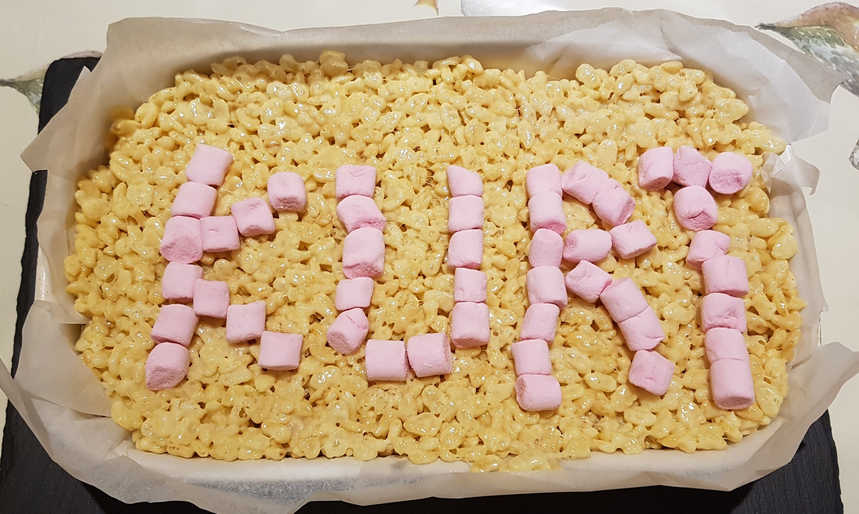
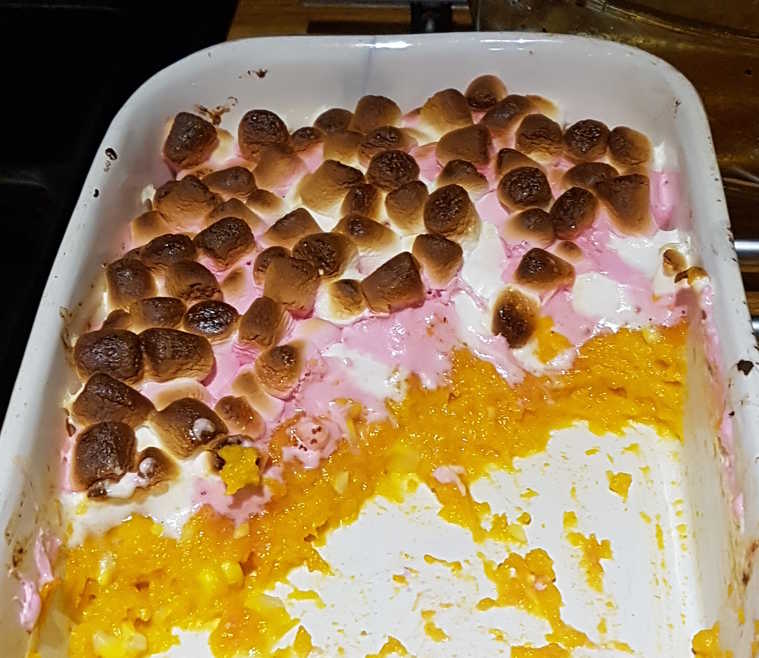
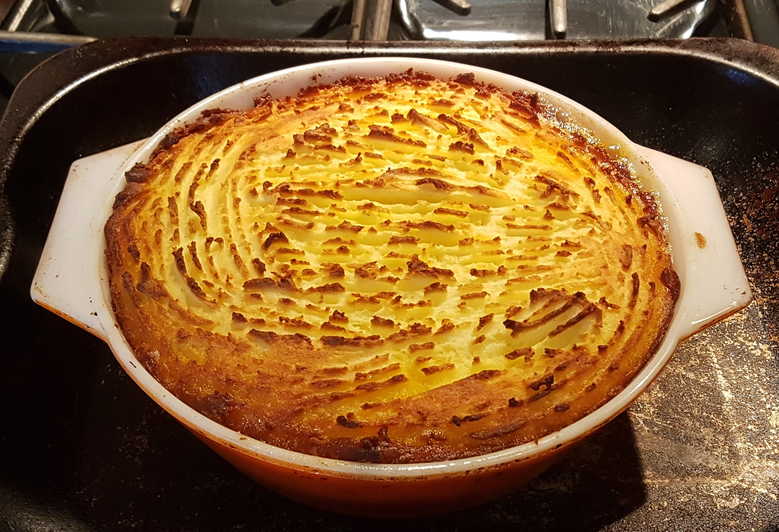
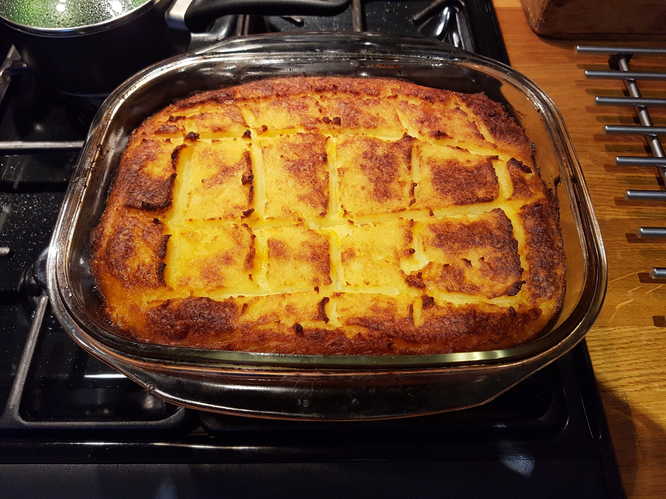
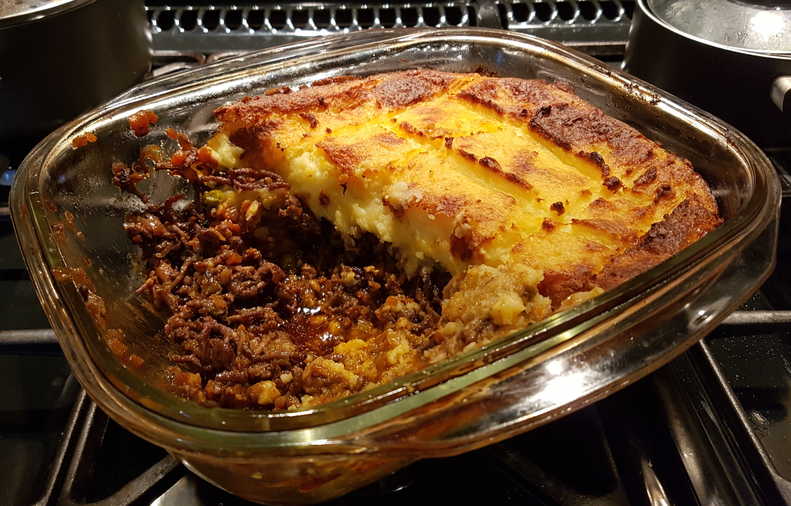
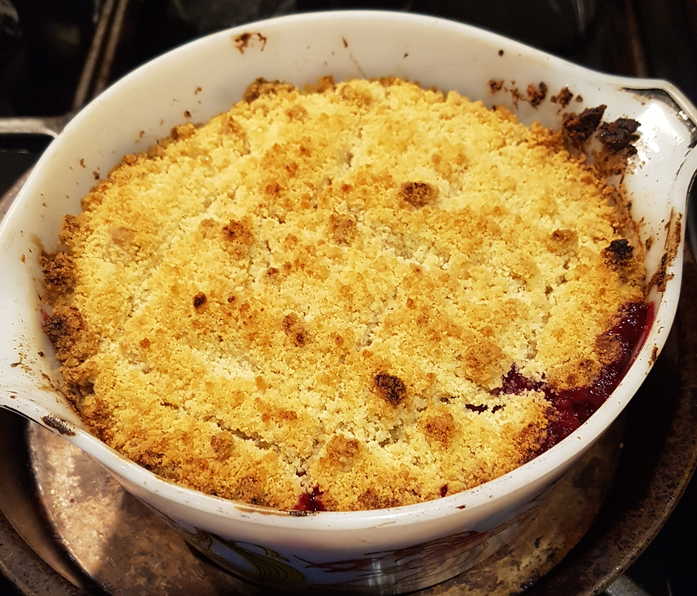
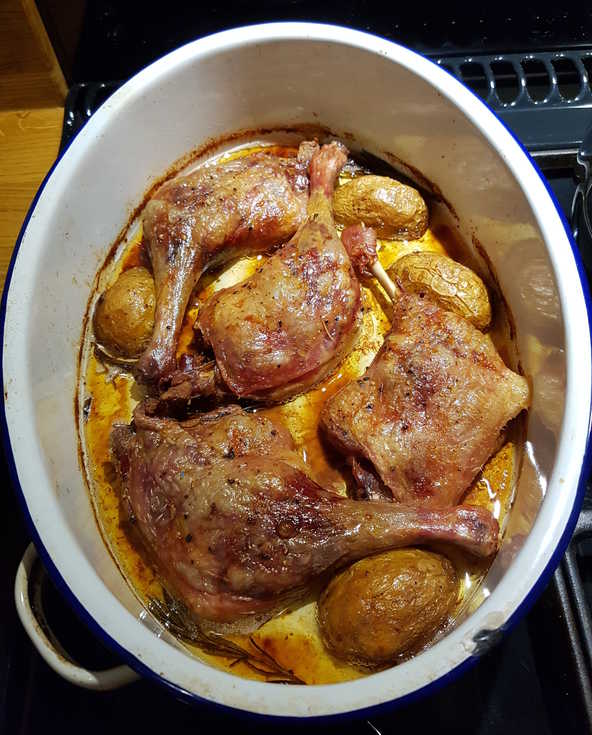
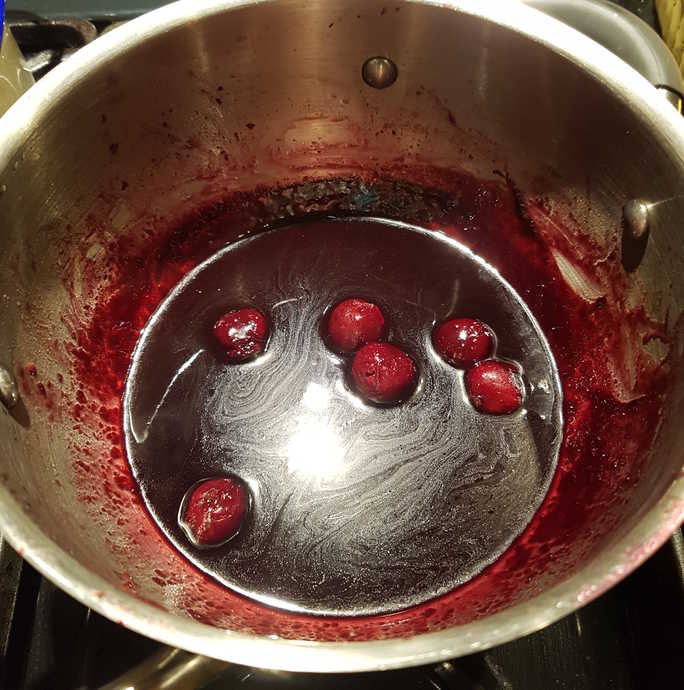
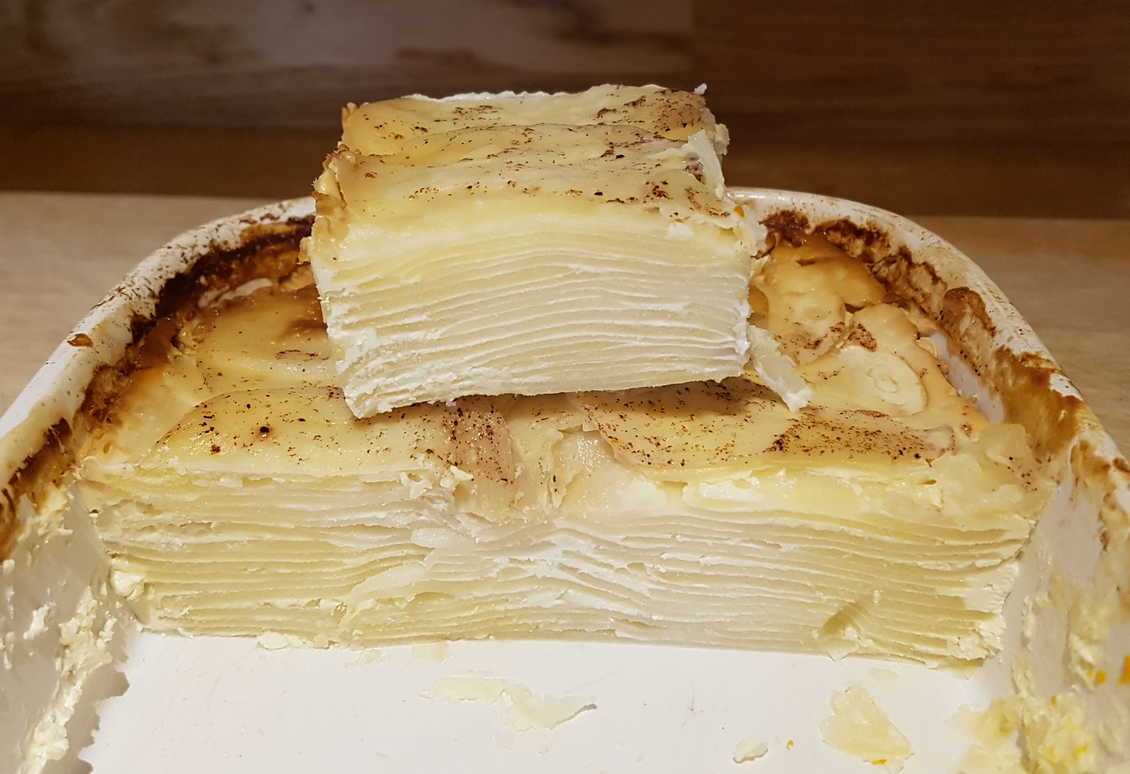
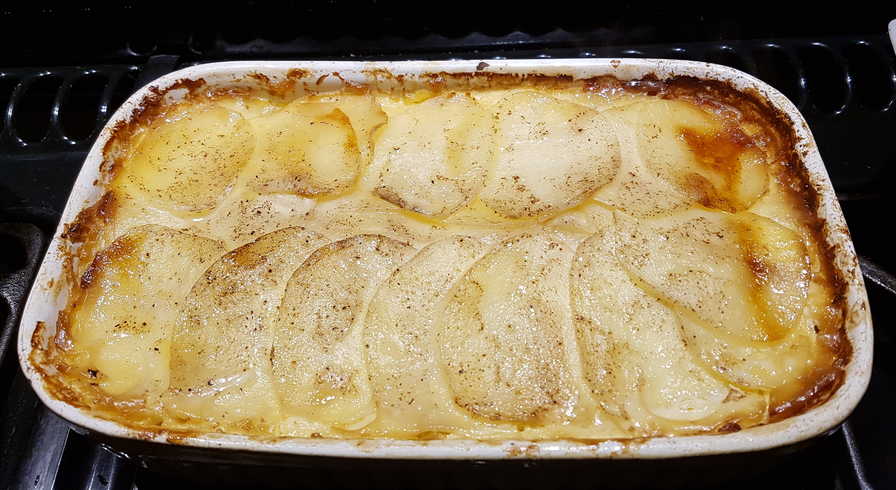
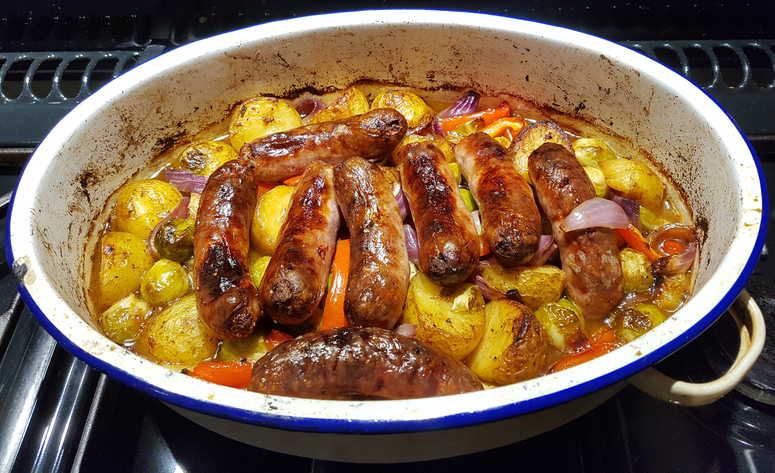
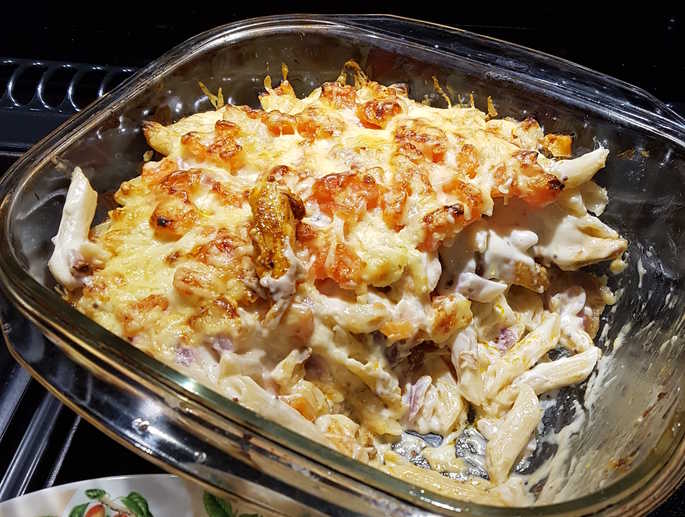
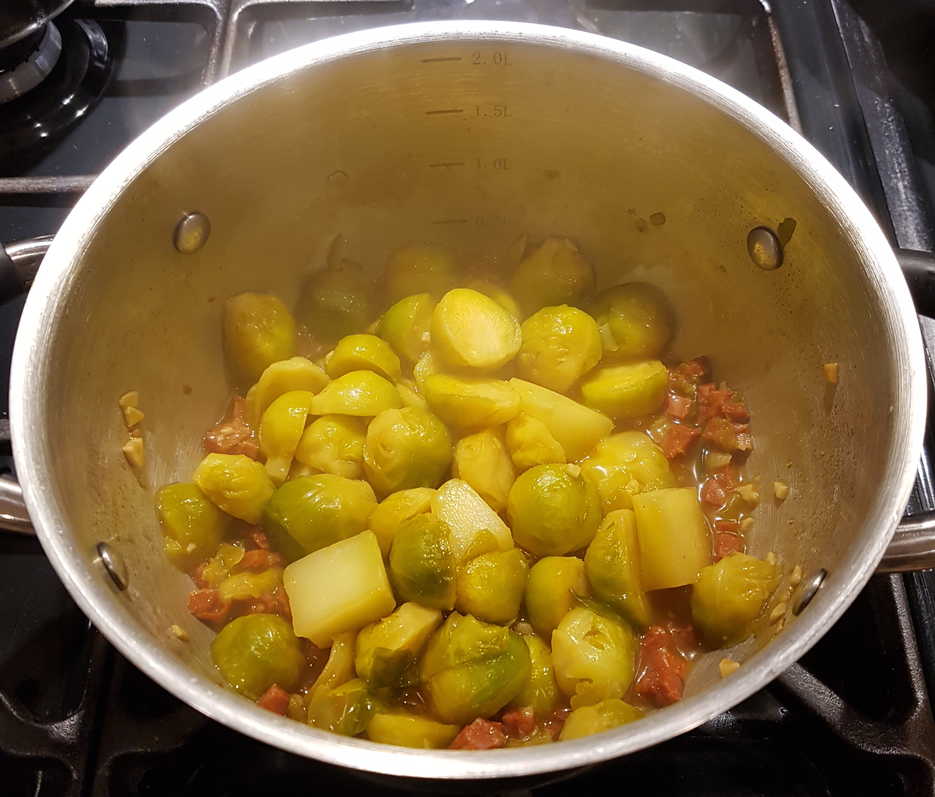
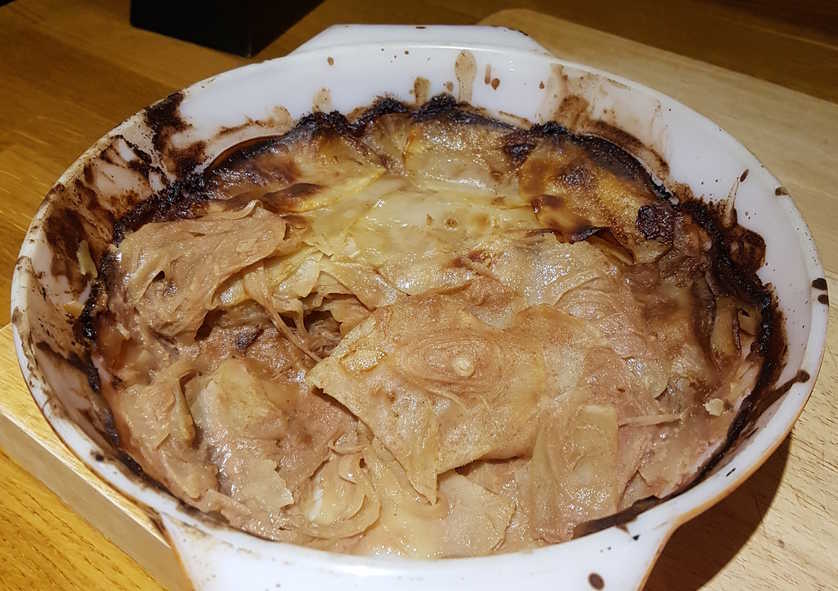
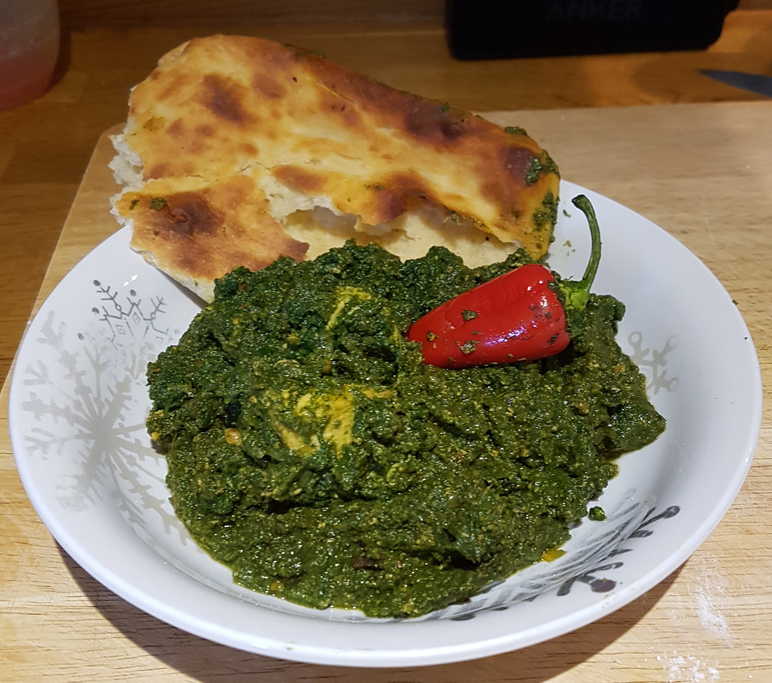
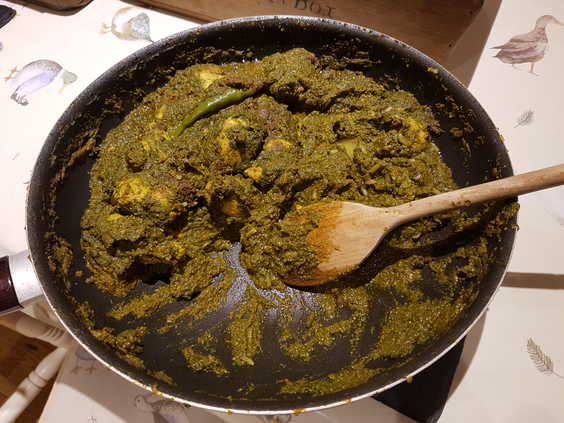
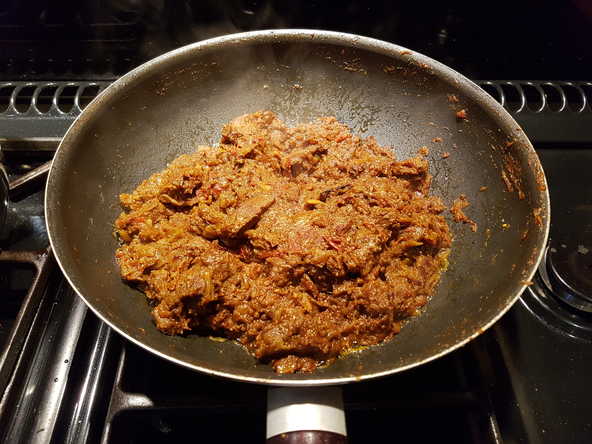
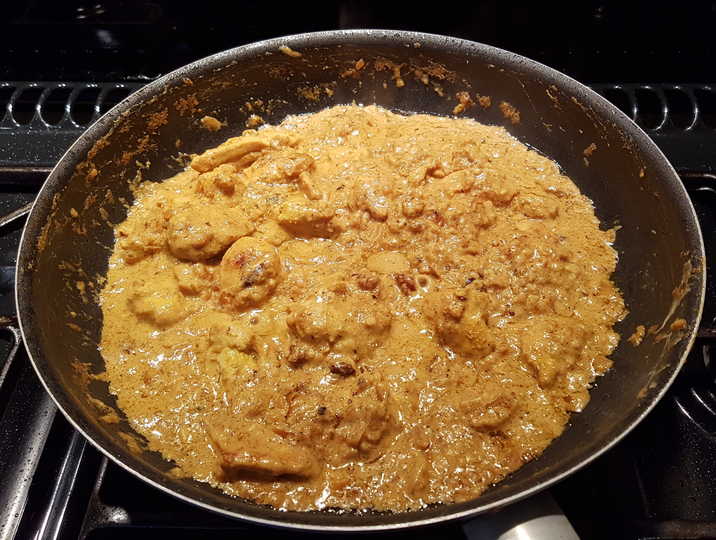
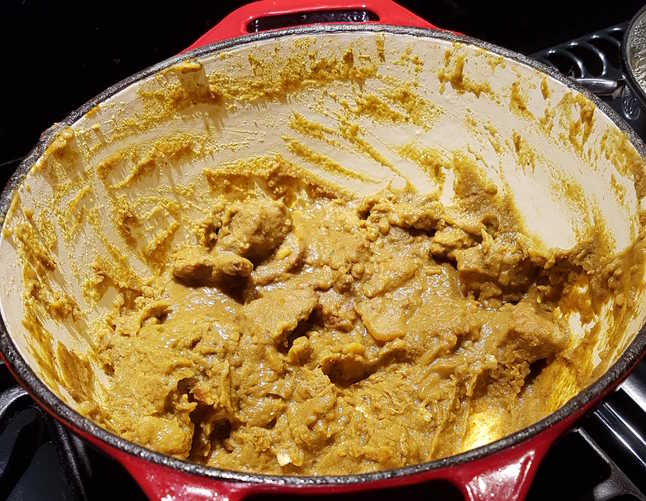
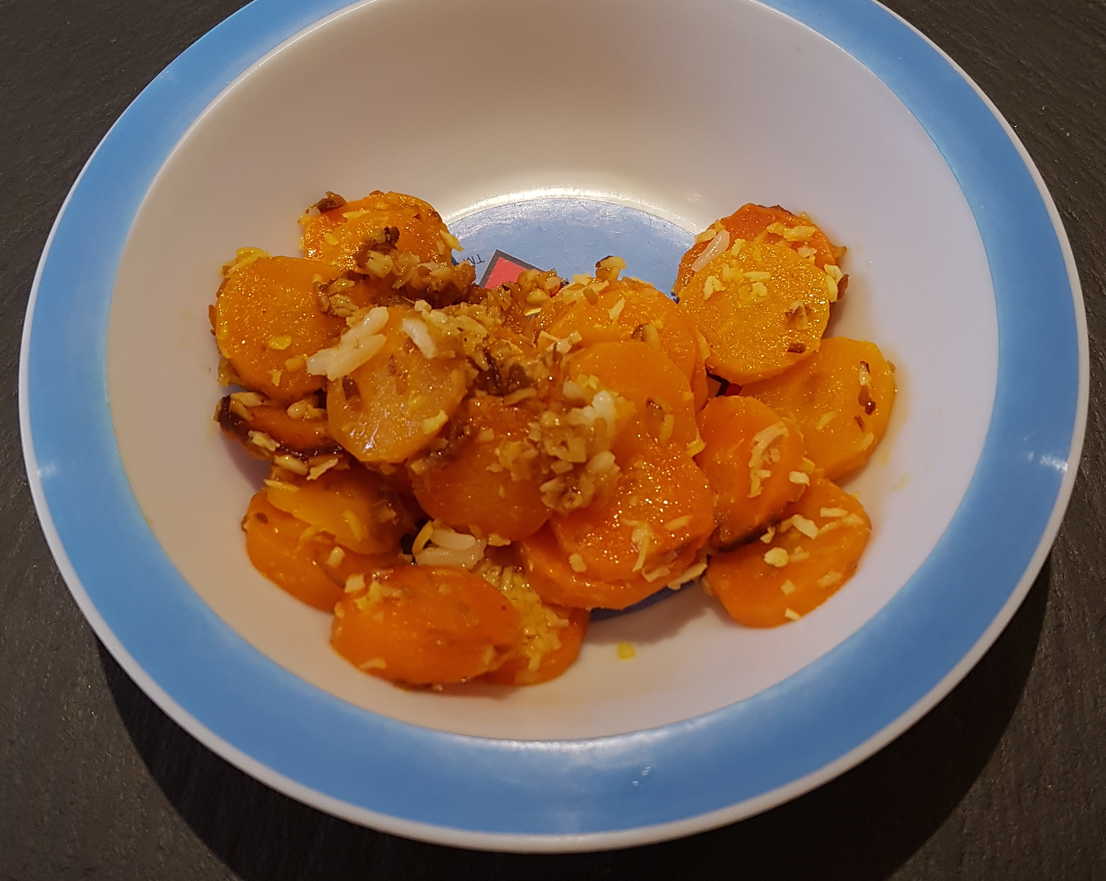
You can melt chocolate over the top of the squares, and I've also heard that you can replace the marshmallows above with Mars Bars.
I can already feel the pain in my teeth :)